15 Red and Black Bugs (Pictures) – Insect and Bug Identification
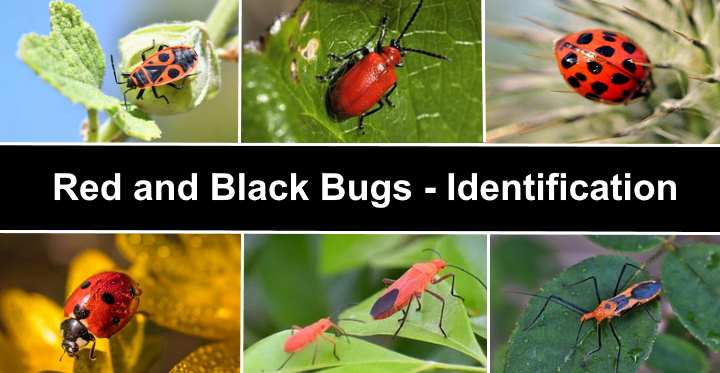
Red and black bugs can be found crawling in your garden, and they can also invade your home. Identifying insects with a red and black body can help know how to get rid of them and if they are dangerous.
The most common red and black insects in yards and houses in spring are boxelder bugs and red-shouldered bugs. The annoying insects can become a nuisance indoors even though they are generally harmless.
Seeing bugs with red and black coloring can create a sense of panic. For example, the oval insect’s black body and bright red or orange dots or stripes could appear dangerous due to warning red colors. Or red insects that have black markings may have a menacing appearance. Some red and black bugs like the boxelder bug can also inflict an irritating bite.
Many people refer to all kinds of red and black pests as bugs. However, not all colorful insects in your house or garden are bugs in the scientific sense. True bugs are insects that belong to the order Hemiptera. The six-legged insects have two antennae and piercing mouthparts that allow the red and black bugs to bite into plant tissue to suck its juices.
This article refers to all types of red and black insects or arthropods as bugs, even though some are not bugs in the true sense. Descriptions and pictures of black bugs with red markings will help identify the creeping crawly you have discovered in your house or yard.
How to Identify Red and Black Bugs and Insects
Apart from the red and black coloring, you can identify a bug or insect by its six legs, two antennae, and if it has wings or not. Red and black bug identification is also possible by observing the insect’s size, behavior, habitat, and distinguishing markings. Some black and red bugs are so tiny you need a magnifying glass to identify them correctly.
For example, flying red and black bugs like boxelder bugs (Boisea trivittata) and red-shouldered bugs (Jadera haematoloma) look similar. However, boxelders have more prominent red stripes on their black body. But, both types of bugs are easy to distinguish from red and black beetles that have rounded hard shells and wings.
Types of Red and Black Bugs (with Pictures) – Identification Guide
Let’s look in more detail at 15 types of common bugs that can be identified by their red and black colors.
Boxelder Bug (Boisea trivittata)
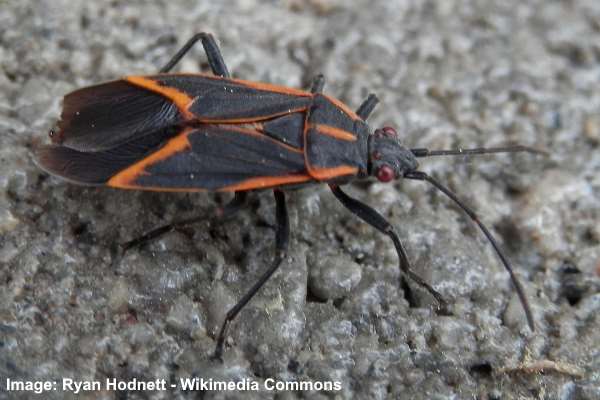
Boxelder bugs have a flat black body with orange-red markings
The boxelder bug is a common black and red flying bug with reddish or orange lines or markings on a flattened, elongated oval body. Adult winged boxelder bugs measure 0.5” (13 mm) long. Boxelder bugs are active from spring through fall and are found on maples, boxelder trees, ash trees, and strawberries.
Like all insects, black and orange boxelder bugs have six legs and two antennae. Adult females lay brightly colored red eggs on host plants. Boxelder nymphs are identified by their bright red bodies and black heads. As the black and orange bugs mature, they become dark gray and develop dark orange stripes.

Adult and nymph boxelder bugs
You may get a lot of boxelder bugs in your home if there is a food source nearby. These small annoying pests enter buildings in summer through open windows, doors, or cracks in the siding or foundation. You may see masses of black and red bugs near cracks as they clamber to get into a house.
The red and black winged boxelder bugs are also excellent fliers and may come from nearby infested boxelder trees.
Black and red boxelder bugs can bite, but it’s rare they bite humans. They are more of a nuisance pest in the home, especially if you have a large infestation. Because the bugs are inactive when it’s cold, turning on the heating may cause them to become active and start crawling throughout your house.
The best way to get rid of boxelder bugs is to prevent them from getting into your home. For example, window or door screens can stop the red and black bug flying into your home. Also, caulking cracks around windows and in walls will help keep all insects out.
Even though boxelder bugs are classified as “scentless plant bugs,” they emit a pungent, foul-smelling odor when crushed.
If you see groups of red and black bugs on the sides of your house, you can spray them with insecticidal soap or hot soapy water to dislodge and kill them.
Red and Black Bug Identification
The boxelder bug is identified by its dark gray or black body, with orange-red markings on its wings and back.
Red-Shouldered Bug (Jadera haematoloma)
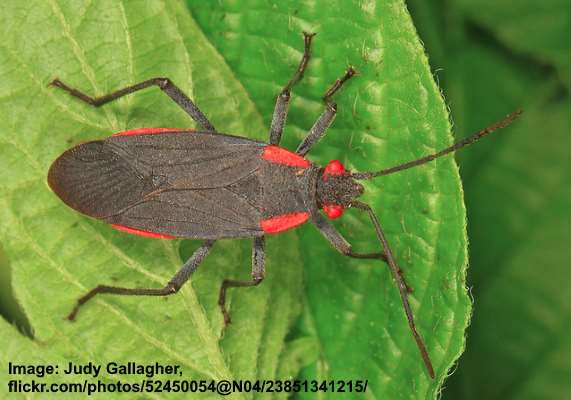
Red-shouldered bugs have a black oval flat body with red markings and red eyes
Also called the soapberry bug, the red-shouldered bug is a black insect with bright red markings on its shoulders and wing edges. The grayish-black bug also has identifiable bright red eyes. The black and red bugs measure around 0.5” (13 mm) long and have distinctive flattened oval bodies.
Red-shouldered bug nymphs have a bright red body and a black head. Like boxelder nymphs, they have black heads, dark brown or black legs, and antennae.
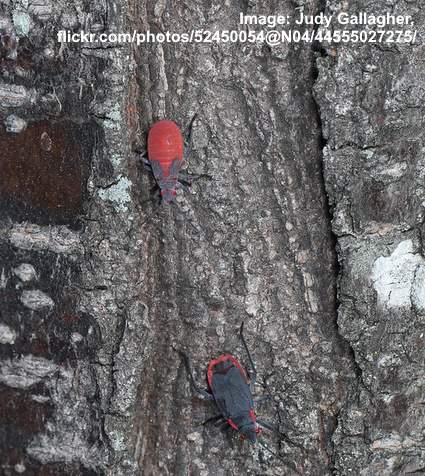
Red-shouldered bug adult and nymph
Red-shouldered bugs are common in Florida gardens. The short-winged black and red bugs are primarily found on host trees feeding on leaves and stems. However, you will also find the bugs on lawns where they congregate in masses to feed on seeds fallen from trees.
Red-shouldered bugs look like boxelder bugs and are classed as scentless plant bugs. The way to tell the bugs apart is by the red markings. Jadera haematoloma is mostly a dark gray or black color with only red shoulders and a thin red stripe running along each edge.
Crushing red-shoulder bugs can leave a reddish stain on clothing.
Red and Black Bug Identification
To identify a red-shouldered bug, look for its elongated oval body with vibrant red colors on its shoulders and body edges.
Milkweed Assassin Bug (Zelus longipes)
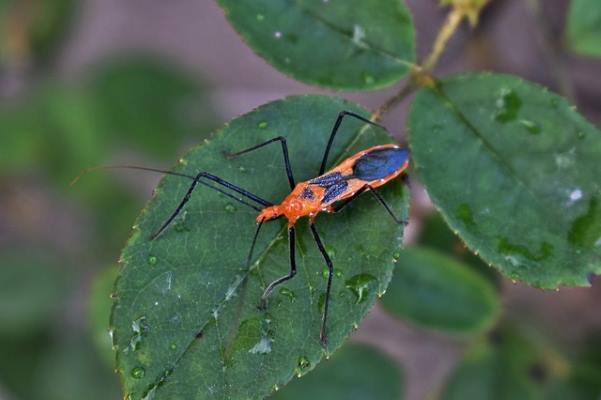
Milkweed assassin bug can be identified by its distinctive red and black colored body, very long antennae and legs
The milkweed assassin bug is identified by its bright red body with black patterns, six long black legs, and pair of black wings. In addition, milkweed assassin bugs have a slender body with an elongated oval abdomen, and a long sucking mouthpart. Up close, pictures of these red and black bugs show they have white markings on the underside of the abdomen.
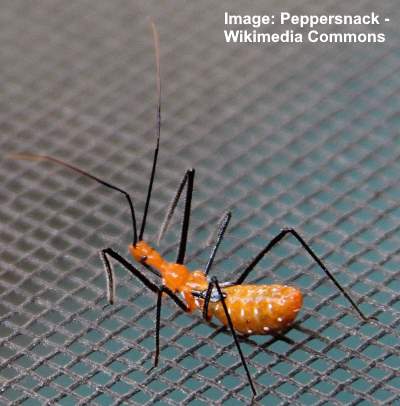
Milkweed assassin nymph
Milkweed assassin bugs measure approximately 0.5” (20 mm) long. The red and black bugs are beneficial insects that prey on caterpillars, flies, mosquitoes, and destructive beetles. The slender bugs are not aggressive, but they can inflict a painful bite if you trap them.
Red and Black Bug Identification
The milkweed assassin bug has an easily-identifiable bright-red and black pattern, slender body with jet black hairy legs, two long black antennae, and a long piercing snout-like mouthpiece.
Firebug (Pyrrhocoris apterus)
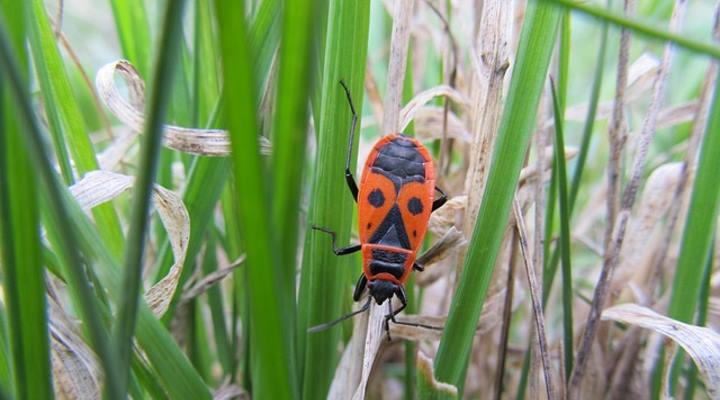
Firebugs can be easily identified by their red body with black round spots and triangular markings
The firebug is a small red bug with black round spots and triangular markings on its back. The striking bug is easy to recognize in gardens due to its distinctive red and black coloration. The small red and black bug measures 0.4” (10 mm) long and can be found feeding on lime trees and mallow trees.
Red and black firebugs are not dangerous because they don’t bite humans or harm trees. However, hordes of creeping crawlies in homes can become a nuisance. Red firebugs invade homes in the fall to overwinter in warmer places.
If you crush them, red firebugs cause a nasty stench, and the smell may attract other insects. Additionally, the red color can leave a stain on clothing and carpets. If you find them in your home, vacuuming them is usually the best solution to get rid of them.
Red and Black Bug Identification
The firebug has an easily identifiable red oval body with two striking black dots and two black triangles on its back. In addition, the red bug has black legs and two black antennae.
Mediterranean Red Bug (Scantius aegyptius)

The Mediterranean red bug is very similar to firebug and both belong to the family Pyrrhocoridae, but the firebug has 2 extra tiny black dots
The Mediterranean red bug is a brightly colored insect with an orange-red body and striking black markings. This seed-feeding red bug is difficult to tell apart from the firebug. The Mediterranean red bug has two black spots and a black triangular hourglass marking contrasting with the reddish-orange color on its back.
The Mediterranean red bug measures 0.27” to 0.35” (7 – 9 mm), and the invasive black and red bug is common in California. The immature bugs are generally entirely red and develop black spots as they mature.
Red and Black Bug Identification
To identify the Mediterranean red bug, look for two black spots and a large black hourglass marking on a red-orange elongated oval body.
Red and Black Blister Beetle (Meloidae)
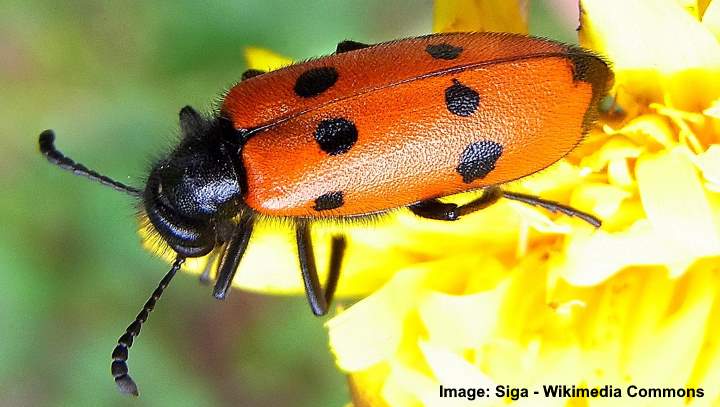
The red and black blister beetle (Mylabris quadripunctata) has a black head and red body with black round spots
Some species of blister beetles are red insects with black spots covered in fine hairs. For example, the Mylabris quadripunctata beetle has a slender, bright red body with two rows of black dots and black markings at its tail. In addition, the red beetle has a small round black thorax and a small black head.
Red and black blister beetles measure 0.4” to 0.8” (10 – 20 mm) long. They usually feed on insects and insect eggs and may also feed on flowers and leaves, causing some damage.
Blister beetles get their name from the poisonous liquid contained in their bodies. This can cause skin irritation and blistering if you squash one of them and the secretion gets on your skin.
Related reading: How to identify types of beetles.
Red and Black Bug Identification
Red and black blister beetles have bright red bodies with several black spots, six black legs, and two clubbed antennae.
Desert Blister Beetle (Lytta magister)
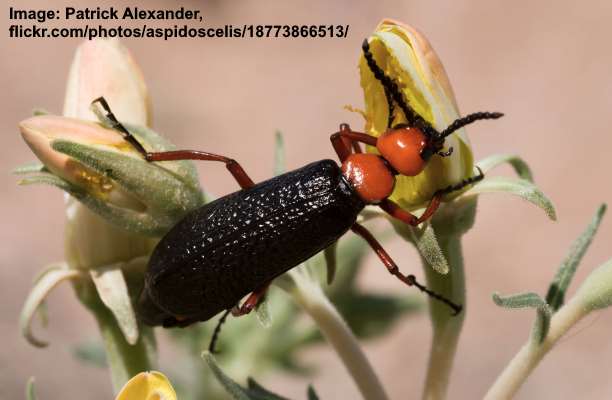
The desert blister beetle has reddish-orange head and black oval long body
The desert blister beetle is a black bug with a red head, black and red legs, and filiform antennae. The large black and red beetle can measure between 0.6” and 1.3” (16 – 33 mm) and is common in California and the southwestern United States. The large beetles can also bite.
The redheaded black blister beetle is commonly found in deserts, mainly feeding on brittlebush flowers. Like all blister beetles, the black and redheaded desert beetle exudes a yellowish, foul-smelling secretion that can cause a painful skin blister.
Red and Black Bug Identification
The desert blister beetle is easy to identify with its deep black body and shiny bright red head, red legs, and two antennae in a filiform shape.
Cocklebur Weevil (Rhodobaenus quinquepunctatus)
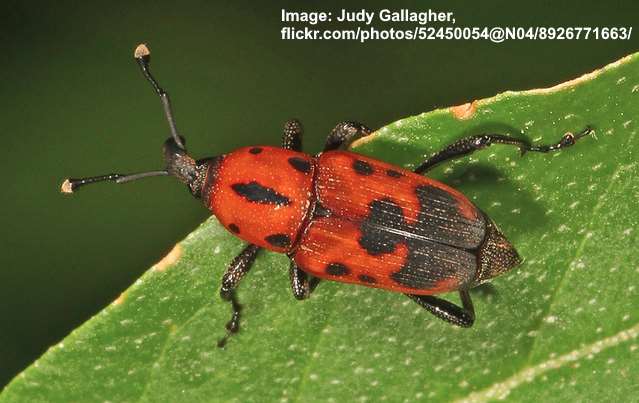
The small cocklebur weevil has a small black head with long snout and black patterns on its red body
The cocklebur weevil is a type of red and black bug with an identifiable black rounded snout, characteristic of all weevils. The red cocklebur weevil has an orange-red body, thorax, and a tiny black head. Identifiable black spots on its back contrast with its red-orange body.
Red and black cocklebur weevils measure approximately 0.25” to 0.5” (6 – 13 mm) long. The tiny insects generally feed on cocklebur, ragweed, or thistle leaves.
This species of red weevil, Rhodobaenus quinquepunctatus, also goes by the name five-spotted billbug. Depending on the species, other types of red and black weevils can have more or fewer black dots on their red bodies.
Red and Black Bug Identification
The cocklebur weevil is easy to identify due to its dark orange to red body, black spots, black legs, a long black snout, and two geniculate antennae that look like they have joints.
Bee Assassin Bug (Apiomerus crassipes)
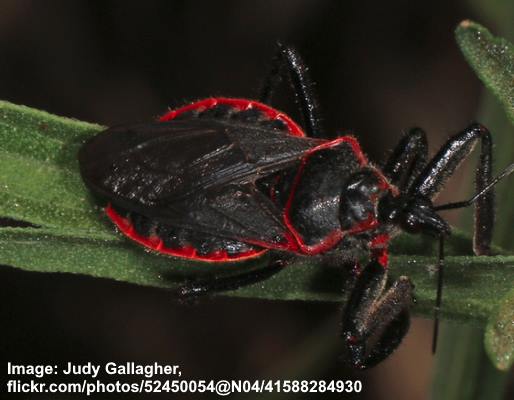
The black bee assassin is a flying bug with red markings on the sides of its body
The bee assassin bug is a black bug with red markings along the sides of its abdomen. These dark-colored bugs have a triangular-shaped body, six black legs, and two thin, wiry antennae. Bee assassins are also flying bugs that go from plant to plant, hunting bees and wasps.
Adult bee assassin bugs measure between 0.55” and 0.78” (14 – 20 mm) long. The black and red bugs are common throughout North America and are active from mid-spring until late fall. You will often find bee assassin bugs on pine trees.
Red and Black Bug Identification
The bee assassin bug is identified by its flattened body that is mostly black with reddish or orange margins, thick hairy legs, and thin antennae.
Italian Striped Bug (Graphosoma italicum)
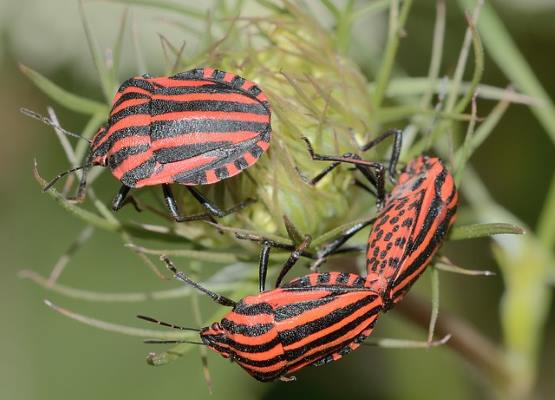
The small Italian striped bug has a shield shaped body with alternating black and orange or red stripes
The Italian striped bug is a striking black bug with orange-reddish stripes and a body in the shape of a shield. Also called the minstrel bug or harlequin bug, this small red and black striped bug has six black legs and thin, pointed antennae. The rounded bug measures between 0.31” and 0.47” (8 – 12 mm) long.
There is no mistaking an Italian red and black striped bug if you find one in your garden. The bug can be found feeding under the umbrella-like flowers of plants in the family Apiaceae —parsley, carrot, celery, hemlock, and hogweed.
The black and red stripes of the harlequin bug are a warning sign to predators.
Red and Black Bug Identification
The easily identifiable Italian striped bug is red with thick black stripes running longitudinally down its rounded, shield-shaped body.
Two-Spotted Stink Bug (Cosmopepla conspicillaris)
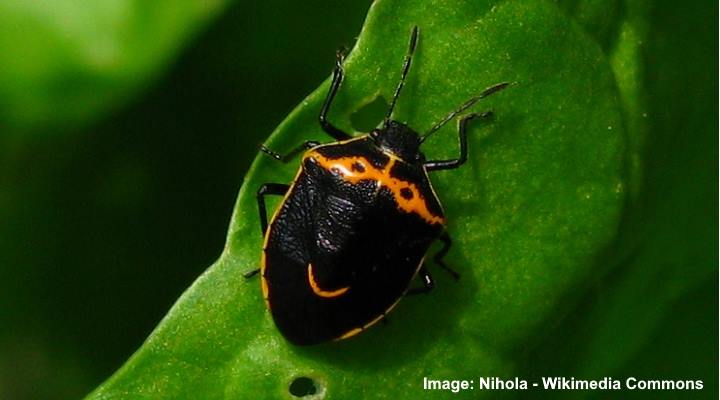
The two-spotted stink bug has a black shield shaped body with orange-red band and two black spots
The two-spotted stink bug is a black bug with an orange-red band near its head and thin orange lines along its margins. The underside of this unusual shiny black bug is yellow with black stripes. The attractive black bug with its orange markings is a tiny bug that measures approximately 0.3” (8 mm) long.
Other common names for the two-spotted stink bug refer to its unique red or orange speckled patterning. For example, it’s called the happy bespectacled stink bug black bug. This refers to the red and black spectacle-like markings and the red or yellow semi-circle resembling a smile on its back.
Red and Black Bug Identification
The two-spotted stink bug is identified by its orange-red band that looks like a pair of colorful spectacles near its head. Other recognizable features of the stink bug are slender antennae, yellow markings on its belly, and a U-shaped bright marking on its back.
Red and Black Ladybugs (Coccinellidae)

The seven-spotted ladybird (Coccinella septempunctata) is common in Europe and was successfully introduced into states in the US
Ladybugs are easily recognizable beetles due to their rounded red wing coverings with black spots. Red and black ladybugs measure between 0.04” and 0.4” (1 – 10 mm) long. The red bugs have wings and can swarm into buildings in the fall. Some types of ladybugs are yellow and black.
Related reading: How to identify various types of ladybugs.
Asian Lady Beetle (Harmonia axyridis)
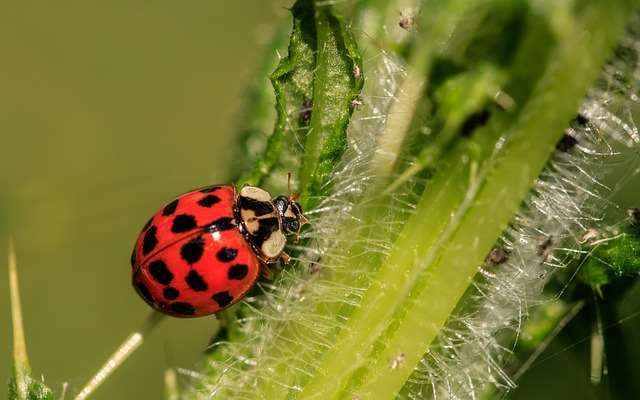
The Asian lady beetle is now becoming a pest in many countries
The Asian lady beetle is an invasive species in North America in the ladybug family. The flying bugs can be red with black dots or black with red spots depending on the species. The small red and black adult beetles measure 0.2” to 0.3” (5 – 8 mm) long.
Asian lady beetles look similar to native ladybugs but they bite and can cause allergic skin reactions.
Black Clock Beetle (Pterostichus madidus)
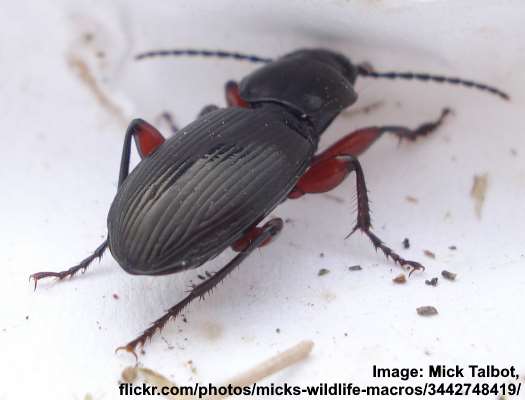
The black clock beetle has red legs with spines and black ridged body
The black clock beetle is described as a black bug with red legs. Up close, pictures of the black beetle show its black and red legs have spines, and its shiny black abdomen is ridged. The black clock beetle measures 0.55” to 0.78” (14 – 20 mm) long and is found in gardens.
Scarlet Lily Leaf Beetle (Lilioceris lilii)
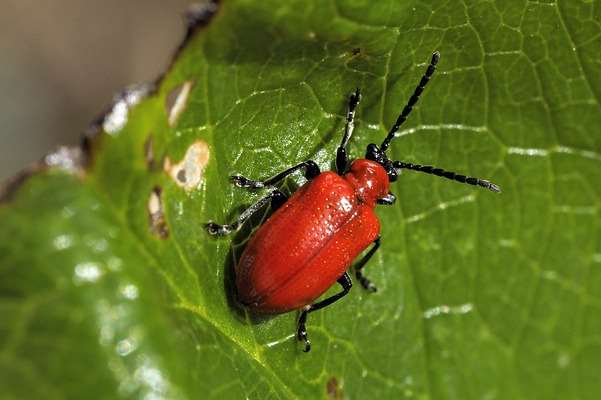
The scarlet lily leaf beetle is also called red lily beetle, or lily leaf beetle and is shiny red with black legs and antennae
The scarlet lily beetle is a bright red leaf beetle with black head, legs and antennae that eats the leaves, stems and flowers of lilies and other plants from the family Liliaceae. Adult lily beetle measures about ¼–⅜ inch (6 to 9 mm) in length.
Related articles:
- Small Brown Bugs – Identification Guide With Pictures
- Types of Green Insects – Identification Guide
- Small Black Bugs – Identification Guide
